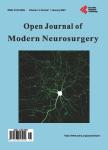The Use of Hinged Craniotomy in Comparison to Cisternostomy for Avoiding Bone Flap Replacement Second Surgery in Cases of Decompressive Craniotomy in Traumatic Brain Injury
The Use of Hinged Craniotomy in Comparison to Cisternostomy for Avoiding Bone Flap Replacement Second Surgery in Cases of Decompressive Craniotomy in Traumatic Brain Injury作者机构:Department of Neurosurgery Cairo University Cairo Egypt
出 版 物:《Open Journal of Modern Neurosurgery》 (现代神经外科学进展(英文))
年 卷 期:2019年第9卷第1期
页 面:7-16页
学科分类:1002[医学-临床医学] 100214[医学-肿瘤学] 10[医学]
主 题:Decompression Subdural Hematoma Cisternostomy Traumatic Brain Injury
摘 要:Introduction: Acute post traumatic subdural hematoma is a clinical condition with increased morbidity and mortality despite the developments in neurosurgery and urgent intervention is required to have best clinical outcome. We will evaluate hinged craniotomy technique in terms of offering adequate brain decompression plus avoiding removal of bone flap which requires second replacement surgery in comparison to cisternostomy effect. Material and Methods: A prospective study was conducted over 30 patients with traumatic acute subdural hematoma presented to neurotrauma unit in Cairo University hospitals from January 2017 to February 2018, operated by hinged craniotomy plus evacuation of hematoma and duroplasty. We avoid rapping the head with elastic bandage post-operative. Generous subcutaneous dissection (5 - 7 cm) all around skin flap was done routinely. Effect of brain decompression was evaluated by measuring the level of brain in relation to skull in post-operative computerized topography. Results: Twenty-one patients operated with initial GCS less than eight. Ten cases (33%) show that cortical surface in relation to skull bone was at inner table, nine cases (30%) at diploid layer and two cases (6.7%) at outer table in post-operative CT brain. Twenty patients died (66.7%);eight patients (26.6%) became fully conscious and two patients (6.7%) had vegetative outcome. No re-operation was done in any of our patients. Conclusion: Hinged craniotomy may be a safe and effective alternative technique with comparable results to cisternotomy in cases of traumatic brain injury that require decompression to avoid second surgery, especially in centres lacking cisternostomy experience. Although gaining cisternostomy experience may help in other indications, future prospective studies with larger number are required.



